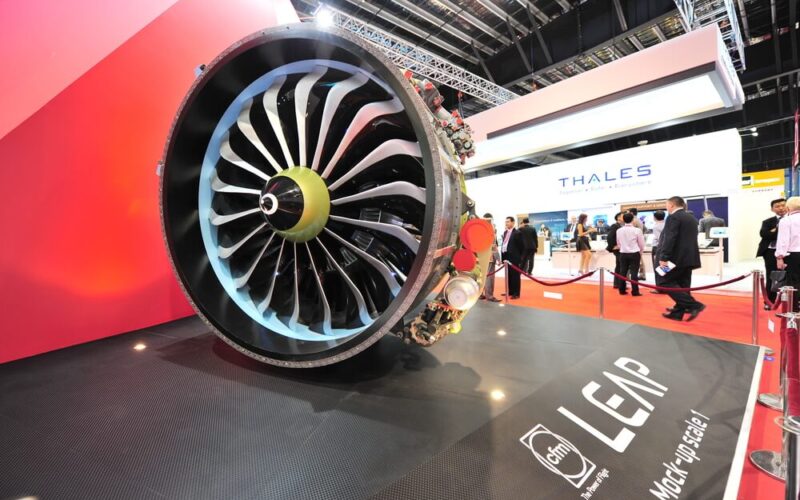United States government officials are considering blocking the sale of the CFM LEAP-1C engine to COMAC, the manufacturer of the C919, according to people familiar with the matter.
Currently, the only engine option developed for the Chinese competitor to the Airbus A320 and Boeing 737 MAX is the LEAP-1C, manufactured by CFM International.
GE has requested to prolong a license to export the engines to China to power the C919, which is currently undergoing flight testing. The final verdict whether to permit GE to export the engines is set to be discussed on February 20 and February 28, 2020, during two separate meetings, discussing how strictly the United States should limit the exports of technology to China, reports Reuters.
People who are close to the question indicate that one of the reasons for blocking the sale of the LEAP-1C is to prevent China from reverse-engineering the power plant. However, one of the underlying issues could be the rising competition for Boeing. The Chicago-based manufacturer indicated in its Global Market Forecast that through 2038 China would need over 8,000 new aircraft deliveries, with 5,960 of those being single-aisle jets.
And the competition for the single-aisle market is getting more and more intense, as Airbus and COMAC are only increasing their presence in the segment.
Heating competition for Chinese aviation market
In November 2019, Airbus and China shook hands to increase their cooperation. As per the agreement, the European manufacturer is to increase the monthly output of the Tianjin, China Final Assembly Line (FAL) from the initial three A320 aircraft per month. In addition,Tianjin would also host the A350 XWB in the wide-body Completion and Delivery Centre (C&DC). Airbus indicated that Tianjin’s FAL would produce six narrow-body aircraft per month by the end of 2019, doubling its productivity from its original design.
The COMAC C919, a narrow-body aircraft seating up to 168 passengers with a standard range of 4,075 kilometers and an extended-range version flying up to 5,555 kilometers, has already amassed 815 orders from 28 customers, states the manufacturer’s page. The Chinese-made jet is intended to compete with the A320 and the 737 families, despite the fact that both the A320neo and the Boeing 737 MAX 8 are, arguably, vastly superior: both Western-made jets can seat more passengers and fly much further.
However, the one advantage the C919 has is the fact that it is Chinese-made. With the majority of Chinese airlines being state-owned, the local government is more than interested in selling the C919 to the companies it owns.
For Boeing, that means that the 5,960-strong single-aisle market is threatened by the increasing presence of the A320neo and C919. After all, Boeing has also established a 737 Completion and Delivery Center in Zhoushan, China. The delivery center, established together with COMAC, delivered the first 737 MAX to Air China in December 2018. The manufacturer’s data indicates that Chinese airlines have ordered 185 MAX aircraft, with 865 more 737s associated with an Unidentified Customer(s), indicating that, potentially, more Chinese airlines have signed up for the newest iteration of Boeing’s most-successful narrow-body.
Trade spat not helping Boeing
The China-United States trade war, which started in early-2018 resulted in a drought for Boeing: the last order from a Chinese operator came in November 2017, when Juneyao Air ordered a single Boeing 787 Dreamliner. Boeing’s latest delivery to China was on January 5, 2020, when the company shipped two Boeing 737-800 NG aircraft to China Eastern Airlines (CIAH) (CEA) . While the 737 MAX crisis had its fair share of impact on the short-term order and delivery drought, the trade war is not helping the situation either.
During a press call discussing Boeing’s 2019 financial results, the company’s executives said that China is a big deal for the demand of aircraft. Specifically, the planemaker expects a Chinese airline to make an order sooner rather than later, as there is no reason to believe the two trade-battling countries have to sign a Phase Two deal for an order to come. China and the United States signed a Phase One agreement on January 15, 2020.
Nevertheless, China is not the only market that the C919 can potentially threaten. The COMAC-built jet can become the Panda Diplomacy of aviation, or in other words, a way to show off an improving relationship with China. With the growth of surrounding markets in Asia-Pacific and in Africa, where China is increasing its presence in various methods, including the Belt and Road Initiative, the soft power of the country could put a dent not only in the demand for Boeing’s state-of-the-art narrow-body products but Airbus’ as well.
And with the two global superpowers bickering at each other constantly, the United States preventing the C919 from having an engine, could be a way for the country to flex its own political muscles. On the other hand, losing the Chinese market, which is on its way to becoming the number one aviation market in the world, would present quite a few problems for U.S. based aerospace manufacturers, including Boeing and the aforementioned General Electric.

